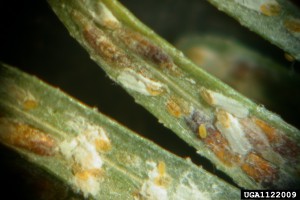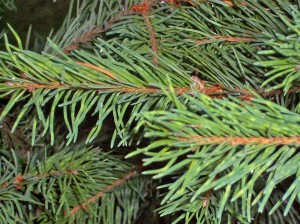Seeing spots on your landscape conifers? It might be elongate hemlock scale. It’s not just on hemlocks anymore – it’s been reported on firs in the Hudson Valley, western NY, and the Southern Tier.
Scales – and this is a hard scale, so it has a handy protective cover for itself – suck the contents out of the cells of the needle, which causes the yellow spots when there are lots of them. If you flip the needles over, you can see elongated brown or white scale covers – brown are female, white are male. Break open that brown cover and you might see tiny yellow eggs. One of the problems is that the eggs are laid over a long time-span – so there are almost always eggs!
The eggs hatch to crawlers which move to a new site on the same or a neighboring tree and then settle down to eat and build their own covers. And lay more eggs, of course.
Too much nitrogen fertilizer can make the problem worse. The scales survive better and lay more eggs. Stress – like not enough water or too much water – makes the trees more attractive to the insect. And if you use a pesticide that kills off the good guy beneficial insects like ladybugs, the scale numbers will actually increase!

So what can you do?

If you are buying new plants, check them to make sure you don’t bring scales home accidentally.
If your trees are already planted, check them carefully for scales. If there are just a few, prune out and destroy the needles or branches if possible. Check other trees nearby to see if any crawlers have made the long hike.
Also, if you are working in trees with scale, always go there last so you don’t spread crawlers from tree to tree on your clothes.
Horticultural oil applied when the trees are still dormant in spring can help. Remember that oils remove the blue color of trees like blue spruce.
Want to be sure that you have elongate hemlock scale? Send a sample to the Insect Diagnostic Lab at Cornell.
See pictures of all the stages at Forest Pest Insects in North America: a Photographic Guide.